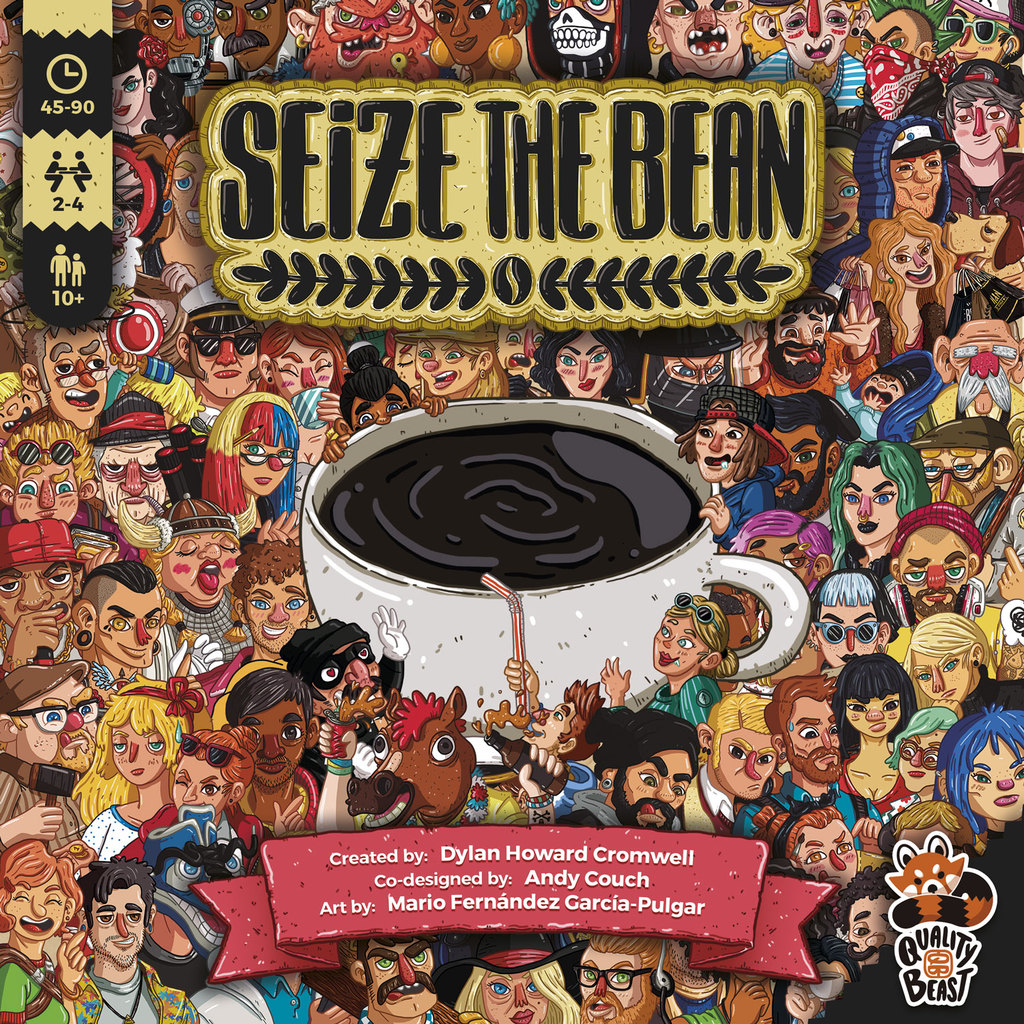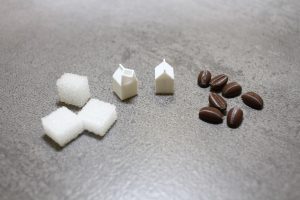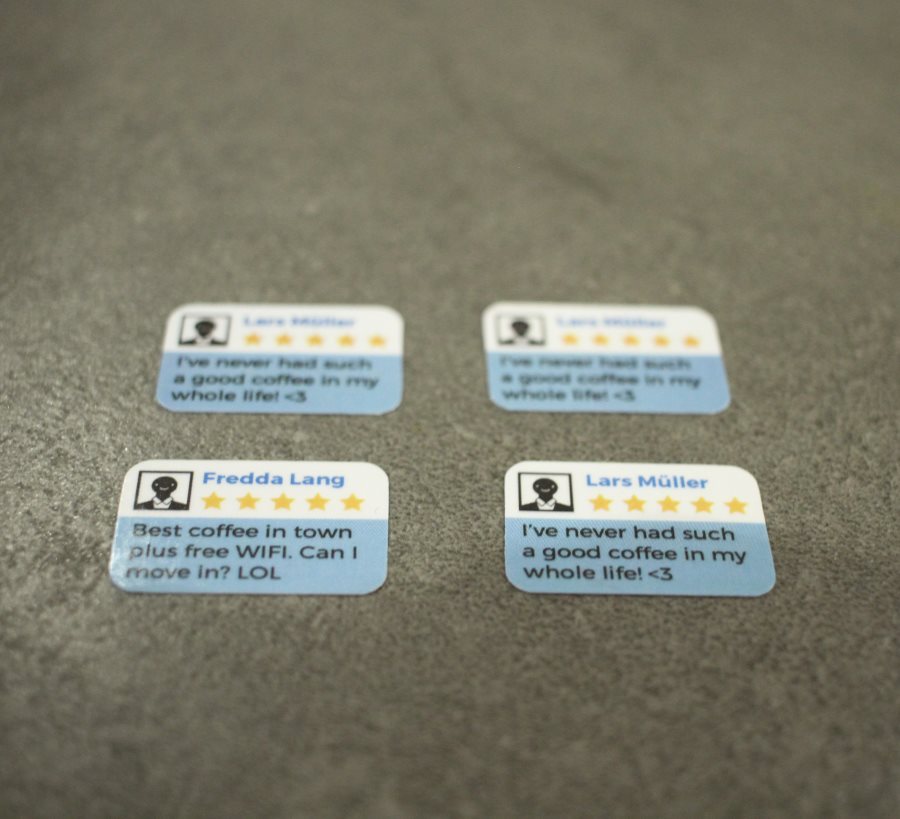Seize the Bean (2018)

In my mid-twenties, I despised hot drinks, considering drinking the contents of a pub garden’s ash trays and a cup of coffee to be similar experiences. Ten years later, I can barely function without a cup of coffee inside me, the smooth brown gold of the high-street well and truly having got its latches into me. Heck, I’m even owned by a household espresso machine. Anyone who lives in the same house as one of these gadgets knows what I mean, what with the continuous servicing the mechanical beast requires to pump out its fine addictive substances without giving you some sort of fungus poisoning. If I’m not rinsing it, I’m emptying it. If I’m not emptying it, I’m descaling it. Every so often the motorised overlord demands I feed it water. It’d be less effort to drive to a Starbucks…
Hence, you can but imagine my excitement/dread at the offer of a review copy of Quality Beast’s inaugural title, ‘Seize the Bean’, designed by Dylan Howard Cromwell, a table drafting game with an economic bent, where the players operate as baristas setting up competing indy coffee shops in metropolitan Berlin. I mean, it couldn’t be any more work than my real espresso machine, could it?
In Seize the Bean, players are competing to get the most positive reviews from a limited pool, over the course of several day’s trade. The count of reviews in the pool is defined by the number of players and once it’s emptied, the end game is triggered. Positive reviews are garnered via fulfilling the requirements on the customer cards that are queued in front of your shop. However, much like the real service industry, if you don’t meet the fickle demands of the visiting coffee addicts you will acquire negative reviews which will count against your score at the end of the game.
Coffee Art
Let’s get the somewhat less crucial part out of the way first – the art collateral in this game is technically spot on. The iconography is largely consistent, bar the one pair of icons which mean the same thing (near as darn-it) but present differently across different card types. The art direction, whether it suits your tastes or not, is very polished and harmonious, nothing standing out or jarring. Quality Beast have gone for a bold look, giving Mario Fernández García-Pulgar free reign and, for me, it absolutely works. Sure, some folks have said to me the portraits ‘look weird’ but honestly, isn’t that meant to be capturing the quirkiness of the cosmopolitan folk of Berlin?

Of more universal appeal is the tokens. The 3D printed coffee beans, milk cartons and sugar cubes are amongst the finest prototype components I’ve ever seen, going down a treat with everyone I’ve put this game in front of. I’m sure once they are mould cast they will only get even better! The sugar cubes are so realistic that if I left them out in my kitchen they’d cause a horrible PLA poisoning incident with my Mother-in-Law’s next cup of tea.

I could wax lyrical on the cuteness of the three dimensional components but the pictures will say more than I ever could. So, let’s move onto our house speciality – game-play.
Does it house-blend?
A game round is broken up into four key phases, which I have called ‘Feeding’, ‘Restocking’, ‘Word of Mouth’ and ‘Administration’. They have cuter terms for the phases in the manual but this has worked for the folks I’ve played with as it’s relatable for my play group. I’m sure you’ll bear with me as, frankly, if you wanted to read a manual you’d be doing so…
Feeding an Addiction
During the feeding phase, in turn order, everybody assigns resources from their reserves to match the recipes on the customer cards queued in front of their shop, having to strictly fulfil orders from left to right. Customers have base requirements that must be met in order to avoid bad reviews and trigger their customer ability. They also have bonus needs which may be fulfilled in order to receive ‘patience tokens’ which trickle out as positive reviews throughout the course of the game.

These demands can vary from the games basic resource (coffee beans & milk) to the more esoteric, be it croissants, quality beans or soy milk. Strangely, one can choose to fob off customers with particular demands by just ‘throwing twice as much stuff at them’, doubling the resource spend. Want a nice coffee? Sorry Chuck, no can do – have a bucket of slop instead buddy. You want soy milk? Sorry – how about double the cow’s milk? That’ll sort out the lactose intolerance come vegan lifestyle choice.
(Sure, it’s an abstraction but at times it feels like a lazy one, certainly for milk)
Each customer is processed in their entirety before moving onto the next card in the row including the (normally) mandatory triggering of present customer abilities, often positive but occasionally negative. Should you make them happy enough to give you a good review, you leave them in your queue ready for the next day’s trade. Should they merely be ‘meh’, they’ll go into your discard pile, not being willing to make your coffee haunt part of their daily routine. If they leave a bad review, you’ll not only carry the negative one victory point, but if you are currently carrying three or more poor appraisals they will leave your deck forever…

Each player’s queue resolves independently, so it’s absolutely possible to accelerate this phase by simultaneously assigning their resources onto their customer cards and just doing the ‘show and tell’ in turn order. Being absolutely strict, this phase features a notional ‘steal other people’s unfulfilled customer’ mechanism, whereby competing baristas can choose to serve an opponent’s unhappy customer in order to gain the rewards from the card, which of course could affect resource allocation in one’s own customer queue. I wouldn’t worry too much however, as when I said ‘notional interaction mechanism’, I really meant it. This opportunity for interaction never came into play in our games as, more often than not, we were either feeding without fail or the odd time someone slipped up, we were happier leaving our opponents with angry customers going home to write crappy reviews than taking the time to help them out. I could see the advanced rules whereby I get to claim the customer from my opponent’s deck change this calculation somewhat, arguably to the point where I’d make it a core rule.
10lbs of Beans in a 5lb Bag

The ‘venti’ share of the interaction is derived from the ‘Restock’ phase, during which players will take turns assigning one of their two worker tokens to either improving their coffee shop’s offering, or restocking raw materials to serve customers on future rounds.
If a player chooses to improve their coffee shop, they partake in the open table draft, selecting either a customer, produce or décor card from independent trade rows which, upon being acquired immediately replenish.
If the taken card is a customer, it is added to the player’s discard Dominion style, eventually cycling into the baristas customer pool (read: draw pile). You’re done. That’s it.
Should the claimed card be a supply card, it is placed next to the restocking action spots on the player’s personal board, enhancing future restock actions with a tableau of overlapping cards, thereby imbuing them with improved efficiency. Additionally, a new icon type will be added to the player’s tableau enabling them to serve a wider range of customers more efficiently. Remember those esoteric requirements for such luxuries as ‘not rubbish coffee’ I mentioned earlier? These cards help you with those.
Finally, if a décor card is acquired, it is placed next to the ‘draft a card’ action spots, enhancing the utility of these spots by providing bonuses when different types of cards are drafted, be it positive reviews, free ‘hype’ (hype defines draw rate through the players customer deck) or bonus raw materials. These cards help you make an engine that helps you make your engine. (?) The trick here appears to be to know when to stop and to focus on the act of making coffee. How quaint.
If a player chooses to replenish their supplies, they merely activate their personal action spots (zero interaction here folks) picking up coffee beans, milk or sugar plus any bonuses they have baked into their engine during prior rounds. Worthy of note is that sugar represents ‘all snack foods you have in stock’ – Schrödinger’s Pretzel if you will. Unlike force feeding vegans cow juice, it’s an abstraction I can live with to keep the game elegant.
Guerrilla Marketing

Once everyone has taken their two actions for the day, players will look at their topmost supply & décor cards, inspecting them for customer preference icons (they all have them), representing what types of customer the goods & features will appeal to. In turn order, if possible, every player must draft a customer matching one of the icons into their discard pile as the good word spreads about your coffee shops new moustache waxing booth (hipster bait) or on-site cruelty-free puncture repair kit (cyclist fodder).
Backroom administration
At the end of the working day (round), you’ll move the trade rows on by one card, creating new opportunities for card drafting. Helpful if you’re waiting for a donut supply card to drop…
[Despite this forced card churn, it’s entirely possible to get stuck in a ‘donut hole’ of your own creation, with a queue of donut craving customers lined up and not even a bear-claw in sight. This is not a metaphor or a laborious pun, but rather a technical term used by elite gaming athletes. Probably.]
You’ll then draw customers equal in number to your current level of hype, pass on the first player token and recommence the feeding, beginning the next turn.
Once the final good review is taken, the round is played to completion and one more bonus ‘feeding’ is triggered, exclusively using supplies on hand, to close out the game. This extra mini-turns essentially gives people one more opportunity to run the engine they have invested time into creating, allowing them to pull VP from the reserve. To my mind this is a canny choice by the designer, serving to act as punctuation to the game’s proceedings. An exclamation point, if you will, and a final opportunity to milk your customers for their often game-changing splash effects.
For once, I’ve taken a few liberties with the detail here. There’s a mechanism around claims in the end-game scoring, whereby whoever is the most specialised in each of the customer types (icon counting) which feature in your game can claim one good review for each card of that variety in their deck, be it customer, supply or décor. There is a nice sense of push and pull to the element whereby you want to go deep to ensure a big pay-outs on your wins, but go somewhat broad in order to deny your opponents claims where plausible.
Furthermore, there are some in game, non-exclusive rewards for filling your pantry and front of house with depth of product/feature (three matching icons) and product/feature variety (five mismatched icons. Big payoffs are on offer here. Sure, mechanically it’s nothing to write home about, and I can’t say it added that much to my experience but I can see why it’s there, another factor to shape your drafting decisions.
I should also mention the optional dexterity game mechanic, whereby you introduce variability in your efficiency for picking up a core resource you cannot operate without, specifically the coffee beans. The players may optionally (did I mention it’s optional?) choose to use the included scoop to dig for coffee in lieu of just picking up six beans, receiving anywhere between zero and nine beans.

It’s cute but the fun wears off quickly in my experience, people often using the ‘dexterity scoop’ in an act of gamer parody and absolutely no-one gracefully accepting a bad pickup result. Let’s not do it, then pretend we did, yeah?
A game of Seize the Bean will complete in about 45 minutes to my experience, trending slightly upwards the more players you involve. This is because the feeding phase demands a bit of presentation from the players to get the most out of it thematically, and to maintain some idea of what other players are aiming to achieve/work out how to knobble them.
A Returning Customer?
So having had my somewhat uncharacteristically sterile description of proceedings, you may be wondering how I rate ‘Seize the Bean’? It’s a fair question, as I’m still not 100% sure.
On the one hand, it’s got fantastic presentation and does something quite unique with deck building, specifically a ‘build your own challenge’ approach that I think is laudable. When you first take cards into your discard pile, you think it is going to be ages before you have to deal with them entering your queue. However, the individual rounds rip along quickly enough that before you know it you need soy milk, which you neglected to draft. Whoops.
On the other hand, the interaction present in the game didn’t particularly impress me. In a low player count, the table drafting was too predictable and at the top end (four players) I found it a little too chaotic, the one ‘cake’ card you wanted being scooped up before you even got a chance to even examine it properly. The premise of stealing another players customers during feeding seems an appealing opportunity for interaction in principle, but because people often prioritised feeding their high value cards, there was little incentive to feed their dregs over allowing them to generate a negative review. It effectively became scripted.
Additionally, I tend to favour table drafters that don’t replenish the card pool mid-round. If my taking a card in the round exposes a decent card for my opponent, it feels too much like ‘output random’ and leaves a bitter taste in my mouth, much like a burnt espresso. I can’t see how this game would work in the absence of live refresh, the churn rate of the cards being too low for you to effectively achieve anything, nonetheless it’s contrary to my particular tastes.
Changing the optics back to ‘to-go mug half-full’, Seize the Bean was fun whilst I was developing the mastery of it. It reminded me of the sort of self-induced death spirals one can achieve in ‘The Bloody Inn’ where you have to keep murdering policemen to cover up the murders, but at some point they are going to come along in numbers you can’t slaughter your way out of. Imagine that, with less murder, more coffee and a sprinkling of crappy TripAdvisor reviews.
However, being realistic it didn’t take me that long to develop a decent degree of mastery at which point the fun reduced, significantly. I didn’t get the ‘feeling like a God’ type endorphin spikes from this game that one might derive from being fully in command of other titles.
One thing I should probably cover now, whilst I’m feeling sufficiently pedantic, is that although billed as an economy game, Seize the Bean doesn’t operate like any economy game I’ve yet to experience. Its ‘collecting resource’ into ‘matching recipes’ outputting ‘points’ workflow feels far more like a contract-focused, engine-building Euro.
Not a bad thing in and of itself, but please go in with the right expectations.
There’s no stocks, shares or dividends in this title. There’s certainly no global supply or demand manipulation, those elements only being adjusted on a ‘player local’ basis. The only currency in sight is that of ‘good reviews’, so price setting is not a possibility, let alone a factor. Perhaps I’m being coarse, but to me, if it smells like a Euro, tastes like a Euro and looks like a Euro, it’s no more an economy game than it is a skinny latte.
So, where does ‘Seize the Bean’ fit into my routine? I’d play it again if someone requested it as it does something fundamentally different with deck building, a mechanism for which I thought I’d pretty much seen it all. However, I can’t see it being a regular title in my rotation, as there’s nothing dragging me back to it, beyond the promise of a wider customer pool facilitated by the success of the rampaging Kickstarter. I almost need to forget what I’ve seen in the past ten days to get enjoyment out of it, as learning to be a barista was certainly more fun than actually being one. In life, as in art.
Despite this, I’m exceedingly excited to see what Quality Beast publishes next. There’s a level of technical polish in their inaugural title that cannot fail to impress. Furthermore, the innovation of some elements in the design can’t really be denied. Despite it feeling like other familiar in many ways, new twists are reasonably abundant, common tropes only being reused boiler-plate fashion for scoring elements and the game clock. The fact that this game didn’t excite me doesn’t mean it won’t excite you, as it’s not fundamentally flawed. It’s just not my cup of tea.
At the time of publishing, Seize the Bean is heading to it’s last 24 hours on Kickstarter. Their campaign video, narrated by the sensational Ben Maddox, coupled to their campaign page should give you a great idea what the game is all about.


